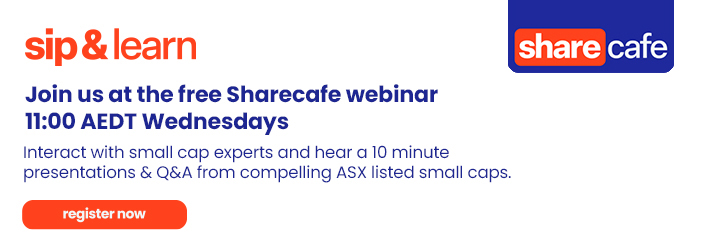- Chapters
- descriptions off, selected
- subtitles settings, opens subtitles settings dialog
- subtitles off, selected
- default, selected
This is a modal window.
Beginning of dialog window. Escape will cancel and close the window.
End of dialog window.
Hazer Group Limited (ASX:HZR) CEO Glenn Corrie provides an update on the company, discussing IP protection and moving into commercialisation.
Peter Milios: I'm Peter Milios from the Finance News Network, and today I'm talking with Hazer Group (ASX:HZR). Hazer Group is trading under the ASX code "HZR" and has a market capitalisation of approximately $68m. Hazer is a pioneering technology development company undertaking the commercialisation of the Hazer Process, a low-emission hydrogen- and graphite-production process. The Hazer Process enables the effective conversion of natural gas and similar feedstocks into hydrogen and high-quality graphite, using iron ore as a process catalyst. Joining us today is Hazer Group CEO Glenn Corrie. Glenn, welcome back to the network.
Glenn Corrie: Thanks, Peter. Great to be here.
Peter Milios: Glenn, you recently announced a milestone in intellectual property protection rights. Could you just comment on the significance of this for the company?
Glenn Corrie: IP is at the core of everything that we do with a technology venture, in particular with Hazer, so nothing's different there. So, you will have seen, in our recent announcement, we've had WIPO, which is the World Intellectual Property Organization, effectively endorse our patentability of a very important component of our technology, the reactor, which is at the core of the tech, and in particular the control systems around that.
So, having this, just again just reinforces the strength of our patent portfolio, our patent protection strategy. And it puts belts and braces, really, around the intellectual property protection and the portfolio that we have. In very simple terms, it basically makes it extremely hard for others to copy us. We are one of the only in the world that is doing this, as you say, decarbonising gas, splitting it into clean hydrogen and an advanced carbon material in the form of graphite with zero emissions. That's a pretty sweet spot to be in.
So, just having that patent protection around it. We know the playing field is growing here, but we've been in development here for 17 years. We've got… I think the latest is that we've something in the order of 70 patents in over 30 to 35 jurisdictions around the world. We are focused on ensuring that we protect the underlying portfolio, but also ensuring that we prepare the company as we move into the commercialisation phase with the strength of the portfolio behind us. So, another important milestone. We don't make updates on the IP frequently, but when we do get big ones like this, it's important that we let shareholders know that the patent and the portfolios are very well protected.
Peter Milios: Now, Glenn, you did mention the reactor control system. Could you just elaborate on the specific functionalities of the reactor control system that was covered by the WIPO, or the World Intellectual Property Organization?
Glenn Corrie: So, folks that are not that familiar with Hazer, we use a reactor called a fluidised bed reactor. It's actually one of the strengths of the Hazer technology. We've repurposed it from the refining industry as well as the metallurgical industry, and that puts us in a pretty unique position because it's already a proven reactor type that we know is scalable. We've seen fluid bed reactors of scales that exceed 50m in height and 10m in diameter. So, we know that, with this particular reactor, that we can get to very large scales where the demand for a lot of our technology is coming from.
So, being able to use that and effectively layer in the control systems for Hazer's technology around that means that we are in a very advantaged position relative to the competition, if you like, in this space. So, it's a really important aspect of our strategy to have the use of a fluid bed reactor and the protection around that as we go into the commercialisation.
If I wind back the clock to when I joined about two years ago, we were seeing demand for our technology sort of 10, 15, 20,000 tonnes per annum. Today we're hearing prospective customers tell us that they want to see 50,000, 100,000, 200,000 tonnes per annum in 2030 and 2035. So, we're basically adapting our strategy to ensure that we can meet the demands of some of these big customers in that timeframe. So, having this portfolio, having the fluid bed reactor and the way that we think about the scale up is very important to the strategy of the company.
Peter Milios: Absolutely. And just given that the fact that the WIPO confirmation strengthens your IP protection, can you share any updates on potential partnerships or licensing agreements for the group?
Glenn Corrie: Yep. So, just to remind everybody, we've got four foundation customers, if you like, already. FortisBC, which is out of North America, a very large utility in Vancouver in Canada. We've got Chubu Electric and Chiyoda Corp in Japan. Chubu Electric is the world's largest LNG importer with their partner in JERA. So, again, a very big industrial customer. Out of Europe, a big French utility called ENGIE, who many will be familiar with. They've got projects in Australia. And then, more recently, the sixth-largest steelmaking manufacturing group, POSCO, out of South Korea. And, again, joined forces with them to provide, or at least be the preferred technology provider for their green steelmaking process.
So, they're the four foundation customers that we've got. Our first cab off the rank, if you like, is FortisBC, which is now progressing through to a final investment decision as early as next year. That's a really important milestone. For us to go from a first-of-a-kind technology, the one behind me, to a commercial facility in North America is a big step for us. And that's, of course, visibility on licence fees and revenues for the company.
So, this is, as I've said before, Peter, this has been a technology that's been in development for 17 years. $120 million has been spent on developing the technology. It's a very exciting place and a big inflection point for the company to be moving into the commercialisation phase with FID and revenues and commercial contracts in front of us in the next 12 months.
Peter Milios: It sounds very exciting. Just with the expanded jurisdiction coverage, are there any specific geographic markets that Hazer is now prioritising for the commercialisation over the next 12 months?
Glenn Corrie: Very good. Yeah, we'd like to think we can cover the world, but we're a small company. I think our priority markets are clearly North America, for the reasons that it's very cheap gas, a big industrial sector, very supportive partnerships and very supportive government policy. So, a very unique market there. And we can actually deliver hydrogen into the North American market for about a dollar a kilogram, which you'll find is extremely affordable and low cost, and one of the lowest costs in the market.
If you go across the pond into Asia, that's another target market, as you know. That's our backyard, POSCO, Chubu, Chiyoda. Mitsui, of course, on our graphite co-product, and lots of other discussions underway there. Another attractive market for slightly different reasons. Slightly higher gas prices, but very unique markets in that there's limited access to carbon capture and storage, and green molecules and green hydrogen therefore, but lots of gas. And so, where you've got a unique condition like that where you've got a big gas market and big industry that's looking to decarbonise, strong policy behind hydrogen strategies, then Hazer's technology fits very beautifully into these markets for very different reasons to North America.
I will give a bit of a shout-out as well for the Middle East. I think, again, very unique conditions in the Middle East. Again, lots of gas, lots of cheap gas, big industry, big players that are looking for decarbonisation. They're very, very serious about it. So, they're the three target markets. Of course, Australia's always our home ground, and we continue to progress lots of opportunities in the Australian arena.
Peter Milios: And just for the shareholders, you've obviously mentioned commercialisation in the next 12 months, but what's some key news flow we can expect within that 12 months?
Glenn Corrie: CDP progress, the commercial demonstration plant, we've been online since January, going very well. Publicly, we've said that we have produced now for over 240 hours. We continue to get great results out of that. We've bagged multiple tonnes now of graphite. That's been a bit of the focus because we've had a lot of prospective customer demand for large-scale volumes of graphite, Peter. So, focusing a bit on gathering a bit of an inventory of graphite for the customer base for large-scale testing.
Look, we're still on track to declare, if you like, the commercial readiness by the end of this year. The CDP is all about continuous operation at an industrial scale and preparing it for commercialisation. I think, as shareholders have watched throughout the year, we've continued to hit the milestones of the CDP. And it's never easy developing a technology, I can tell you now. But we've been through the worst of it a number of years ago, and I think we're now in the sweet spot of really demonstrating to the world that our technology is preparing itself now for commercial readiness. And that's the target for the end of this year, and that's a really big one for investors to keep an eye on.
Funding-wise, we're in a really good position. Of course, as you know, we got out earlier in the year and we've got strong financial position behind us and some non-dilutive milestones ahead. We always see a relatively attractive R&D rebate, which generally comes through in the fourth quarter of every year, so that's another milestone.
Fortis project, of course, there's continued progress on our first commercial project there. We're targeting to try and get binding commercial agreements in place by the end of this year. We've already got a binding agreement that sets the framework for our partnership there. So, there's more news flow there.
Graphite is the sleeping giant here, Peter. We have got now a large volume of graphite. The graphite market just continues to intrigue, and it continues to provide excitement for us. I've spent a bit of time in North America and everybody is talking about graphite. So, it just reinforces the strength of what we have as a technology. Hydrogen, a critical mineral, is a co-product. Both are critical commodities, if you like, and we're very excited about it.
Going to next year, more commercial milestones on the three or four projects that we've got. And I would say look out for a few more strategic partnerships forming as we continue to build out some of the conversations that we've got going in Asia as well as in North America.
Peter Milios: Glenn, thank you so much for your time.
Glenn Corrie: Thanks, Peter.
Ends




